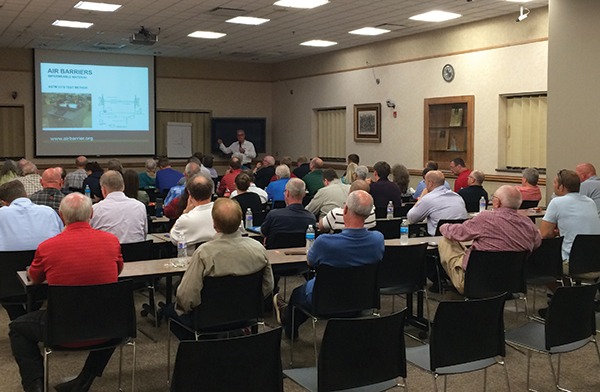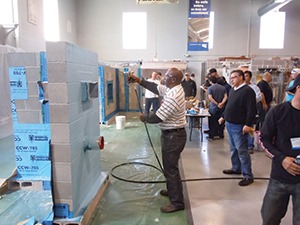Air Barriers
2016 President of the Air Barrier Association of America
By Karen D. Hickey
 Russ Snow, building science specialist for W. R. MEADOWS was recently elected president of the Air Barrier Association of America (ABAA). He took time away from his busy schedule to speak with Masonry Magazine about the ABAA and its relevance to the masonry industry.
Russ Snow, building science specialist for W. R. MEADOWS was recently elected president of the Air Barrier Association of America (ABAA). He took time away from his busy schedule to speak with Masonry Magazine about the ABAA and its relevance to the masonry industry.
Masonry Magazine (MM): Let’s start with an easy question. How does the ABAA differ from the National Air Barrier Association (NABA)?
Russ Snow (RS): The main difference is that NABA is based in Canada, and ABAA is based in the U.S., although some ABAA members are based in Canada. The two groups share a lot of the same educational programs, as well as the Quality Assurance Program. There is definitely some overlap.
MM: Why would a mason or mason contractor be interested in the ABAA or become a member?
RS: The ABAA has done a number of demos and training classes across the U.S. for the masonry industry. We’ve done quite a bit of work with the International Masonry Institute (IMI), partnering with them to train mason contractors on installing air barriers. We also partner with them to conduct half-day and full day general education events. These programs are geared not only toward architects, but also general contractors and trade contractors. The most recent was a half-day?”Air Barrier Education Event”? on June 14 in Kansas City. The presentations covered the basic principles of heat, air and moisture flow and how they impact building performance; the challenges faced when installing air barrier systems; the basic requirements and design considerations of air barriers; and how the latest R&D is reducing the liability during the design, installation and life of these systems.

MM: What do mason contractors need to know about air barriers?
RS: Mason contractors need to ensure the continuity of the air barrier, so it’s important they have a full understanding of it. Oftentimes, the mason won’t be involved in the installation of the air barrier, so they may not understand the importance of its continuity, and they may start putting holes in it. The way masons have been working for decades becomes more complex because substrate preparation of the backup CMU has a significant impact on the air barrier installer.

We do have a number of masonry contractors who have begun installing air barriers as a way to increase their potential scope of work. Some contractors want to “own the wall” ? the backup wall, the air barrier, the insulation and the brick facade. All these elements are connected, so these contractors see it as a business opportunity. The ABAA is helping to train these individuals.
The ABAA offers training and certification in 10 main air barrier materials. Masons tend to become certified in self-adhered, spray polyurethane foam, and fluid-applied air barriers. We’ve trained hundreds of masonry contractors over the years.
ABAA also offers a Quality Assurance Program that can distinguish qualified mason contractors from the rest of the pack.
MM: You’ve mentioned the Quality Assurance Program twice now. Tell us more about the program and its benefits.
RS: The QAP, as we call it, aims to provide the highest level of confidence that the air barrier will be installed correctly and to the highest industry standards. ABAA’s QAP is modeled after the standards laid out in the ISO 9000 program.
The air barrier assembly is often a non-maintainable component of the building enclosure. There is one chance to ensure correct installation prior to the application of other components in the building enclosure. Repair costs can be up to 60 times more expensive than ensuring proper installation the first time around. As such, the job must be done right the first time.
Only contractors who have met ABAA’s mandatory quality assurance and training requirements are awarded accredited contractor status. These contractors have completed air barrier training. They are required to sign a licensing agreement to ensure professional conduct and are obligated to meet the requirements of the QAP on a continuous basis.
The QAP is widely promoted by ABAA to architects, engineers, building envelope specialists, general contractors and owners. The intent of the program is to create a level playing field for contractors to compete on quality, rather than simply on price.
An architect who specifies ABAA accredited contractors and the QAP reaps the following benefits:
- Decrease in liability.
- Assurance that the installation meets the specification requirements.
- Providing the best for your client in an emerging industry.
- Support from an impartial body.
- Detailed records of each project from start to finish.
- Assistance in project discrepancies.
- Technical resources for architects.
In addition, ABAA’s website provides an online search tool to locate the accredited ABAA contractor in your area, or a manufacturer or distributor of a specific product.
The Air Barrier Association of America (ABAA) is a national, not-for-profit trade association for the building enclosure industry. Their membership includes manufacturers, architects, engineers, trade contractors, researchers, testing and audit agencies, consultants and building owners. Their mission is to promote the use and benefits of air barrier systems, educate the public about air barrier systems and develop a professional air barrier specialty trade and industry dedicated to the installation of effective air barrier systems in buildings on a nationwide scale.
ABAA offers training, certification, product evaluations, contractor accreditation and site quality control audits. ABAA is active in the areas of research, education, standards development, building codes and technical resources for the air barrier industry.
For more information, visit www.airbarrier.org.
